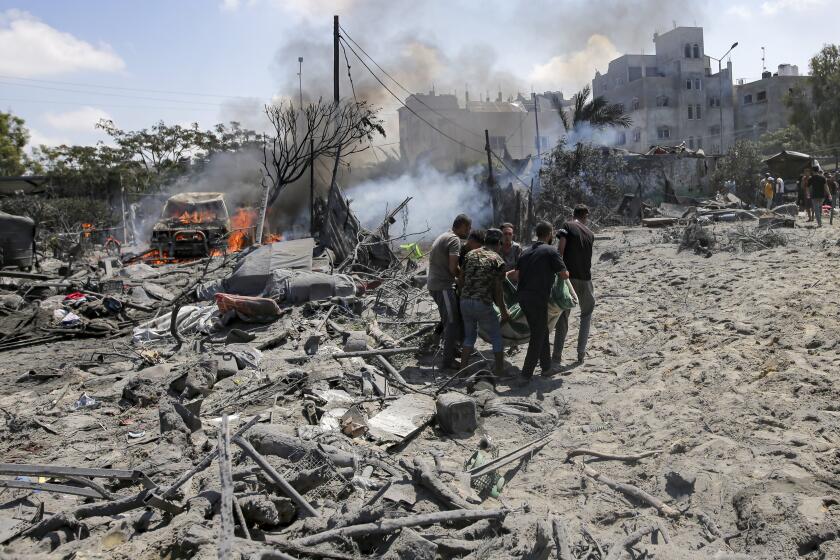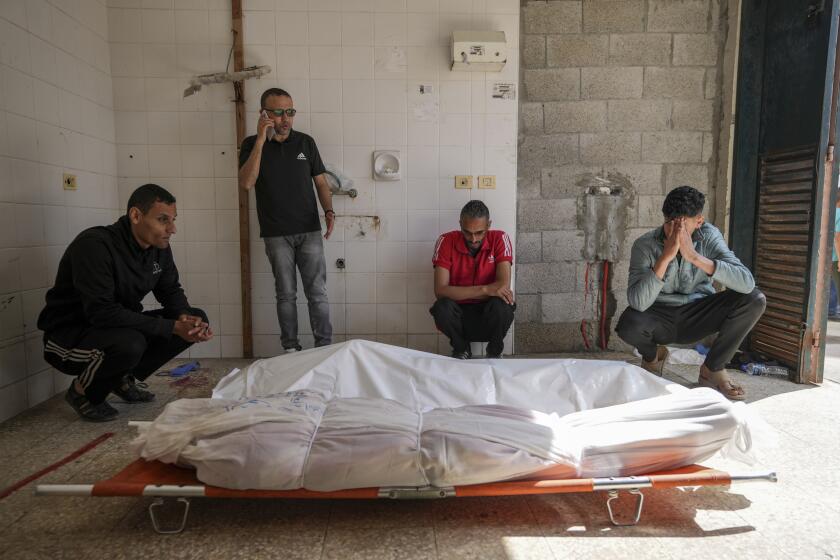Hamas says Gaza cease-fire talks haven’t paused and claims military chief survived Israeli strike

- Share via
MUWASI, Gaza Strip — Hamas said Sunday that Gaza cease-fire talks continue and the group’s military commander was in good health, a day after the Israeli military targeted Mohammed Deif with a massive airstrike that local health officials said killed at least 90 people, including children.
Deif’s condition remained unclear after Israeli Prime Minister Benjamin Netanyahu said Saturday night “there still isn’t absolute certainty” he was killed. Army chief Lt. Gen. Herzi Halevi told journalists Israel attacked a compound where Deif “was hiding” but added: “It’s still too early to summarize the results of the attack, which Hamas is trying to hide.”
Hamas representatives gave no evidence to back up their assertion about the health of a chief architect of the Oct. 7 attack that sparked the war. His killing would mark the highest profile assassination of any Hamas leader by Israel since the war began. Deif has long topped Israel’s most-wanted list and has been in hiding for years.
The Israeli military said Rafa Salama, a Hamas commander it described as one of Deif’s closest associates, was killed in Saturday’s strike. Salama had commanded Hamas’ Khan Yunis brigade. Netanyahu said all of Hamas’ leaders are “marked for death” and asserted that killing them would move Hamas closer to accepting a cease-fire deal.
Hamas rejected the idea that mediated cease-fire discussions had been suspended. Spokesperson Jihad Taha said “there is no doubt that the horrific massacres will impact any efforts in the negotiations” but added that “efforts and endeavors of the mediators remain ongoing.”
Israel says it targeted Hamas’ elusive military commander in a massive strike in southern Gaza that local health officials say killed at least 90 people.
Hamas political officials also insisted that communication channels remained functional between the leadership inside and outside Gaza after the strike in the territory’s south. Witnesses said it occurred in an area that Israel had designated as safe for hundreds of thousands of displaced Palestinians. Israel’s military would not confirm that.
On Sunday, some survivors were angry that the attack targeting Deif occurred without warning in an area they had been told was safe.
“I heard the first hit, and my son came screaming, ‘Daddy, daddy” and took cover with me,” said Mahmoud Abu Yaseen, who clutched his children but then woke up in the hospital to find his son had died. The family had already been displaced five times since the war began. “Where do we go?” he asked.
A United Nations official described utter chaos at Nasser hospital where victims were taken, many treated on bloodstained floors with few supplies available.
“I witnessed some of the most horrific scenes I have seen in my nine months in Gaza,” Scott Anderson said in a statement. “I saw toddlers who are double amputees, children paralyzed and unable to receive treatment and others separated from their parents.” He said restrictions on humanitarian aid to Gaza hamper efforts to provide needed medical and other care.
On Sunday, Israeli Defense Minister Yoav Gallant praised the pilots who carried out the strike and said Hamas is being eroded every day, with no ability to arm itself, organize or “care for the wounded.”
Egyptian state media report ‘noticeable progress’ in talks with Hamas and Israel, but an Israeli official downplayed prospects for a full end to the war.
At least 300 people were wounded in the strike, one of the deadliest in the nine-month war sparked by Hamas’ Oct. 7 assault on southern Israel that killed about 1,200 people, mostly civilians, and took more than 200 hostage.
More than 38,400 people in Gaza have been killed in Israeli ground offensives and bombardments since then, according to the territory’s Health Ministry. The ministry does not distinguish between combatants and civilians in its count.
On Sunday, an Israeli strike in Nuseirat in central Gaza killed at least 14 people at the gate of a school used as a shelter for displaced people, according to an Associated Press journalist who visited two hospitals. Children were among the 15 others wounded. Israel’s military in a statement said it struck “terrorists” operating in the area of a school run by the U.N. agency for Palestinian refugees.
“They are targeting everything,” said a displaced Palestinian, Um Fadi Al-Zeer.
Also on Sunday, police said a Palestinian resident of east Jerusalem carried out a car-ramming attack in central Israel that injured four Israelis, two of them seriously. Israeli border police at the scene shot dead the attacker after he hit people waiting at two bus stops along a busy road. Israel’s military said four of its personnel were wounded, two of them severely.
Israeli police commissioner Kobi Shabtai said such attacks were often “triggered” by events like Saturday’s airstrike in Gaza.
Shurafa and Lidman write for the Associated Press. Lidman reported from Jerusalem. AP writer Abby Sewell in Beirut contributed to this report.
More to Read
Sign up for Essential California
The most important California stories and recommendations in your inbox every morning.
You may occasionally receive promotional content from the Los Angeles Times.












